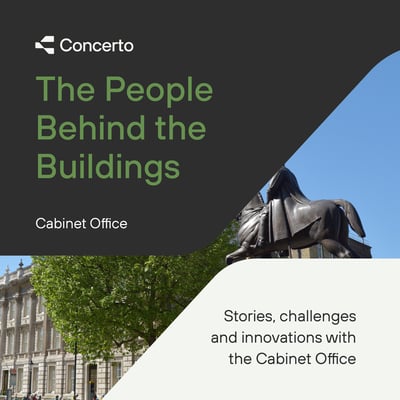
People behind the building: Cabinet office
People Behind the Buildings: The Stories Shaping Our Public Estates
Exploring the leadership, legacy and future of the UK's government estate
In this episode of our People Behind the Buildings podcast, hosts Matt Blanchard from GovNews and Matt Hickley Public Sector Specialist at Bellrock, speak with Lynda Rawsthorne, Head of the Government Property Profession and Director of Property Capabilities, Sponsorship and Standards at the Cabinet Office.
Together, they take us behind the scenes of some of the UK's most iconic public sector buildings, from Whitehall's historic corridors to modern government hubs, and shine a light on the people who keep them running, evolving, and fit for the future.
Meet our guest: Lynda Rawsthorne
Lynda leads the Government Property Profession, representing over 7,500 property professionals across central and local government. She oversees a vast estate of 140,000 buildings, worth £180 billion, providing workplaces for half a million civil servants.
From shaping careers and skills pipelines to delivering strategic transformation across historic and new-build assets, her role places people, capability and legacy at the heart of government estates.
How government estates have changed
Government estates have moved away from siloed ownership and reactive property management to a collaborative, cross-departmental model. New regional hubs like Stephenson Street in Birmingham now bring together multiple departments under one roof, offering:
- Shared services
- Greater efficiency
- Local job creation
- More accessible civil service careers beyond London
This decentralisation is aligned with a wider ambition to drive regional economic growth, supported by the Government Property Strategy's three key pillars:
1. Transforming places and services
Using public estates to enable joined-up public services and regional development.
2. Smaller, better, greener
Improving efficiency, tackling maintenance backlogs, and investing in greener, more sustainable properties.
3. Professional excellence and insight
Upskilling the workforce and using data to drive better decisions.
Heritage meets function: inside Whitehall
The Whitehall estate is home to some of the UK's most storied buildings including what was once the Palace of Whitehall, residence of English monarchs for over a century.
Today, buildings like 70 Whitehall, Foreign, Commonwealth and Development Office and Great George Street still serve as the heartbeat of UK government. These spaces are steeped in history and even make cameo appearances in major films like Spectre and Doctor Who.
But with that heritage comes challenge:
- Protected features (like fireplaces, wide corridors, ornate ceilings)
- High refurbishment costs
- Strict regulations around any updates or modifications
“You never see a building the same way once you're in property, you see both its charm and its challenges.” Lynda Rawsthorne
Creating modern workplaces in historic buildings
Balancing preservation with functionality is an art. Government estates are being adapted to support:
- Hybrid working with flexible zones
- Improved digital infrastructure
- Wellbeing features like bike storage, gyms and quiet zones
- Smart design that integrates modern systems into listed buildings without damaging heritage features
Examples like the newly refurbished Elizabeth Tower (Big Ben) demonstrate the care and cost involved in preserving national landmarks for the future.
Sustainability, innovation and the future of government property
Historic buildings are also central to the government's net zero and climate adaptation goals. Linda highlights the growing importance of:
- Adaptive reuse and conservation-led retrofits
- Low-carbon technologies like LED lighting and solar panels
- Building resilience to climate change without compromising architectural integrity
New builds, such as the upcoming zero-carbon prison in Yorkshire, reflect how sustainability and innovation are driving future-ready government projects.
People, data and AI: The next evolution
Linda sees huge potential in the fusion of property, data and AI:
-
Digital twins and BIM for smarter asset planning
-
Automated condition monitoring
-
AI-driven strategic asset management
-
Real-time insights to prevent failures and optimise spending
“It's no longer just about the building it's about what the building enables, and how we use data to unlock that potential.” Lynda Rawsthorne
Lessons in leadership
Linda views her role as a bridge, translating technical requirements into client needs and ensuring alignment across stakeholders. Whether working with prison services, school estates or government hubs, her focus is on enabling better public service delivery through fit-for-purpose estates.
Looking ahead: What excites Lynda most?
- Sustainability: Retrofitting buildings for low-carbon operation
- AI & Automation: Predictive planning and intelligent asset use
- Inclusivity: Expanding career opportunities beyond London
- Interdisciplinary Working: Blending design, conservation, tech, and policy
Tune in now
From the people maintaining listed government offices to the technologies transforming civil service workplaces, this episode is a celebration of the invisible impact of property professionals across the UK.
The People Behind the Buildings
The new podcast on the block, for all the estate and property geeks to listen to on their lunch break.



